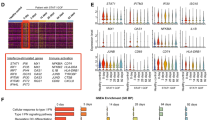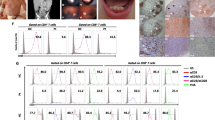Abstract
S100 family proteins are calcium-binding proteins, some of which have been shown to have intracellular and extracellular functions associated with inflammation. The serum concentration of S100A12 has been reported to increase in the acute phase of Kawasaki disease. The purpose of this study was to evaluate leukocyte gene expressions of S100 family proteins in the acute phase of Kawasaki disease. Ten paired blood samples were obtained from ten patients with Kawasaki disease in the acute phase and in the convalescent phase. We examined leukocyte expression levels of 18 S100 genes in the acute phase compared with those in the convalescent phase by using quantitative real-time polymerase chain reaction. Significantly elevated expression of seven S100 genes (S100A6, A8, A9, A11, A12, S100P, and S100Z) was observed in the acute phase. Conclusion:Of the upregulated S100 genes, calgranulin members of S100 genes (S100A8, S100A9, and S100A12) were most highly expressed in the acute phase. Only one S100 gene, the S100A13 gene, exhibited a significantly decreased expression level in the acute phase.
Similar content being viewed by others
Abbreviations
- IVIG :
-
intravenous immunoglobulin
- KD :
-
Kawasaki disease
- RAGE :
-
the multiligand receptor for advanced glycation end products
References
Arumugam T, Simeone DM, Schmidt AM, Logsdon CD (2003) S100P stimulates cell proliferation and survival via RAGE. J Biol Chem 279: 5059–5065
Donato R (2001) S100: a multigenic family of calcium-modulated proteins of the EF-hand type with intracellular and extracellular functional roles. Int J Biochem Cell Biol 33: 637–668
Donato R (2003) Intracellular and extracellular roles of S100 proteins. Microsc Res Tech 60: 540–551
Dinarello CA (1996) Biologic basis for interleukin-1 in disease. Blood 87: 2095–2147
Foell D, Ichida F, Vogl T, Yu X, Chen R, Miyawaki T, Sorg C, Roth J (2003) S100A12 (EN-RAGE) in monitoring Kawasaki disease. Lancet 361: 1270–1272
Foell D, Kane D, Bresnihan B, Vogl T, Nacken W, Sorg C, Fitzgerald O, Roth J (2003) Expression of the pro-inflammatory protein S100A12 (EN-RAGE) in rheumatoid and psoriatic arthritis. Rheumatology (Oxford) 42: 1383–1389
Foell D, Kucharzik T, Kraft M, Vogl T, Sorg C, Domschke W, Roth J (2003) Neutrophil derived human S100A12 (EN-RAGE) is strongly expressed during chronic active inflammatory bowel disease. Gut 52: 847–853
Foell D, Seeliger S, Vogl T, Koch HG, Maschek H, Harms E, Sorg C, Roth J (2003) Expression of S100A12 (EN-RAGE) in cystic fibrosis. Thorax 58: 613–617
Hofmann MA, Drury S, Fu C, Qu W, Taguchi A, Lu Y, Avila C, Kambham N, Bierhaus A, Nawroth P, Neurath MF, Slattery T, Beach D, McClary J, Nagashima M, Morser J, Stern D, Schmidt AM (1999) RAGE mediates a novel proinflammatory axis: a central cell surface receptor for S100/calgranulin polypeptides. Cell 97: 889–901
Jinquan T, Vorum H, Larsen CG, Madsen P, Rasmussen HH, Gesser B, Etzerodt M, Honore B, Celis JE, Thestrup-Pedersen K (1996) Psoriasin: a novel chemotactic protein. J Invest Dermatol 107: 5–10
Komada T, Araki R, Nakatani K, Yada I, Naka M, Tanaka T (1996) Novel specific chemotactic receptor for S100L protein on guinea pig eosinophils. Biochem Biophys Res Commun 220: 871–874
Livak KJ, Schmittgen TD (2001) Analysis of relative gene expression data using real-time quantitative PCR and the 2(-Delta Delta C(T)) method. Methods 25: 402-408
Lloyd AJ, Walker C, Wilkinso M (2001) Kawasaki disease: is it caused by an infectious agent? Br J Biomed Sci 58: 122–128
Mandinova A, Soldi R, Graziani I, Bagala C, Bellum S, Landriscina M, Tarantini F, Prudovsky I, Maciag T (2003) S100A13 mediates the copper-dependent stress-induced release of IL-1alpha from both human U937 and murine NIH 3T3 cells. J Cell Sci 116: 2687–2696
Marenholz I, Heizmann CW (2004) S100A16, a ubiquitously expressed EF-hand protein which is up-regulated in tumors. Biochem Biophys Res Commun 313: 237–244
Miranda LP, Tao T, Jones A, Chernushevich I, Standing KG, Geczy CL, Alewood PF (2001) Total chemical synthesis and chemotactic activity of human S100A12 (EN-RAGE). FEBS Lett 448: 85–90
Moroz OV, Dodson GG, Wilson KS, Lukanidin E, Bronstein IB (2003) Multiple structural states of S100A12: A key to its functional diversity. Microsc Res Tech 60: 581–592
Mouta Carreira C, LaVallee TM, Tarantini F, Jackson A, Lathrop JT, Hampton B, Burgess WH, Maciag T (1998) S100A13 is involved in the regulation of fibroblast growth factor-1 and p40 synaptotagmin-1 release in vitro. J Biol Chem 273: 22224–22231
Nacken W, Roth J, Sorg C, Kerkhoff C (2003) S100A9/S100A8: Myeloid representatives of the S100 protein family as prominent players in innate immunity. Microsc Res Tech 60: 569–580
Newton RA, Hogg N (1998) The human S100 protein MRP-14 is a novel activator of the beta 2 integrin Mac-1 on neutrophils. J Immunol 160: 1427–1435
Prudovsky I, Mandinova A, Soldi R, Bagala C, Graziani I, Landriscina M, Tarantini F, Duarte M, Bellum S, Doherty H, Maciag T (2003) The non-classical export routes: FGF1 and IL-1α point the way. J Cell Sci 116: 4871–4881
Roth J, Vogl T, Sorg C, Sunderkotter C (2003) Phagocyte-specific S100 proteins: a novel group of proinflammatory molecules. Trends Immunol 24: 155–158
Ryckman C, Vandal K, Rouleau P, Talbot M, Tessier PA (2003) Proinflammatory activities of S100: proteins S100A8, S100A9, and S100A8/A9 induce neutrophil chemotaxis and adhesion. J Immunol 170: 3233–3242
Vogl T, Propper C, Hartmann M, Strey A, Strupat K, van den Bos C, Sorg C, Roth J (1999) S100A12 is expressed exclusively by granulocytes and acts independently from MRP8 and MRP14. J Biol Chem 274: 25291–25296
Wicki R, Marenholz I, Mischke D, Schafer BW, Heizmann CW (1996) Characterization of the human S100A12 (calgranulin C, p6, CAAF1, CGRP) gene, a new member of the S100 gene cluster on chromosome 1q21. Cell Calcium 20: 459–464
Wolf R, Mirmohammadsadegh A, Walz M, Lysa B, Tartler U, Remus R, Hengge U, Michel G, Ruzicka T (2003) Molecular cloning and characterization of alternatively spliced mRNA isoforms from psoriatic skin encoding a novel member of the S100 family. Faseb J 17: 1969–1971
Wu T, Angus CW, Yao XL, Logun C, Shelhamer JH (1997) P11, a unique member of the S100 family of calcium-binding proteins, interacts with and inhibits the activity of the 85-kDa cytosolic phospholipase A2. J Biol Chem 272: 17145–17153
Acknowledgements
We thank Dr. Yachiyo Ohta, Dr. Takashi Iwai, and Dr. Seido Iwata of Tenshi Hospital and Dr. Mutsuko Konno of Sapporo Kosei General Hospital. We also thank Mr. Stewart Chisholm for proofreading the manuscript.
Author information
Authors and Affiliations
Corresponding author
Additional information
This study was supported in part by a grant-in-aid for Exploratory Research 2002, from Japan Kawasaki Disease Research Centre Foundation.
Rights and permissions
About this article
Cite this article
Ebihara, T., Endo, R., Kikuta, H. et al. Differential gene expression of S100 protein family in leukocytes from patients with Kawasaki disease. Eur J Pediatr 164, 427–431 (2005). https://doi.org/10.1007/s00431-005-1664-5
Received:
Accepted:
Published:
Issue Date:
DOI: https://doi.org/10.1007/s00431-005-1664-5




